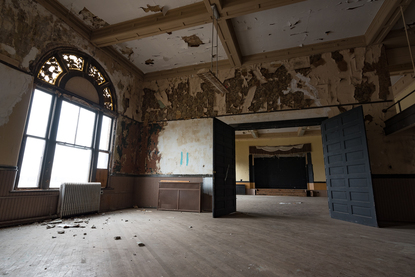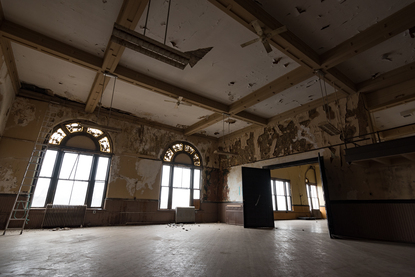
A couple of weeks ago I went to see “Into the Woods” presented by INNOVAtheatre at the Sorg Opera House in Middletown, Ohio. I had never been there and didn’t realize the history behind the theater until I started browsing through the program. The musical was good and performed by a group of really talented actors and actresses with beautiful voices.

With my background in interior design, what really intrigued me was the building. The Sorg Opera House originally opened on September 12, 1891. It was a gift to the city of Middletown from Paul J. Sorg, Middletown’s first multi-millionaire.
First, a little background on Paul J. Sorg…

Paul J. Sorg was born in Wheeling, West Virginia in 1840. In 1852, he moved with his parents and siblings to Cincinnati, Ohio where he apprenticed as an iron molder and attended night school. In 1864, Paul J. Sorg met John Auer, a German-born tobacco roller, in Cincinnati. Auer could make tobacco, but he couldn't keep books. Sorg knew nothing about tobacco, but he was a good bookkeeper. The two men created a company manufacturing tobacco products in Cincinnati.
In 1869, they partnered with another tobacco firm. One of the new partners lived in Middletown, Ohio and urged the newly formed company to relocate and build a new plant in Middletown. Sorg and Auer sold their share of the business and immediately formed another company, P. J. Sorg Tobacco Co., to manufacture cut filler and plug tobacco. This new firm they built up to become one of the largest of its type in the world.

He made his fortune with the P. J. Sorg Tobacco Company, and later the Sorg Paper Company, both located in Middletown. He served as a member of the U.S. House of Representatives from Ohio's 3rd district and served in the Union Army during the Civil War. Sorg also built the Sorg Mansion, which still stands on South Main Street, less than two blocks south of the Opera House.
Sorg Opera House

Samuel Hannaford, who designed Cincinnati Music Hall, was hired by Sorg to design the opera house. The Sorg Opera House included two balconies with a total of 1,200 seats. The lower balcony can be accessed by two staircases on either side of the lobby just before the doors to the main floor. For many years, this upper balcony was segregated seating, and there was a separate entrance on the side of the theater with its own box office and stairs leading directly to the top level. The traveling troupes of performers would take up temporary residence in the basement dressing rooms.

You don’t see a large portion of the building as you walk through the lobby on your way to the theater. The Sorg’s lobby cuts through the first floor of the Sorg’s Commercial Building, which has housed businesses and office space throughout its lifetime. The Armco Club was a social club located in the commercial building, offering entertainment and relaxation space for employees of the city’s largest employer, Armco Steel. Many early photos of the Sorg’s facade show a sign with the Armco logo projecting from the upper floors of the Commercial Building. The Broadway News was a long-time business in one of the two storefronts flanking the theater entrance, operating a news stand and a lunch counter. The top floor housed a ballroom that included a small stage.
The Transformation of the Sorg
John Phillip Sousa performed at the Sorg in January of 1898 after marching down Main Street and again in October of 1919. In 1901, the Sorg began showing early forms of motion pictures, such as photo plays, and vaudeville performances before the operas. Many now famous vaudeville performers played at the opera house, including Marie Dressler, Will Rogers, Al Jolson, Bob Hope and Sophie Tucker. It was also used for civic programs and graduations. The live shows came to an end in the late 1920s, and a sound system was installed in the summer of 1929, turning the Sorg into a full-time movie theater.

An oval frame above the stage, at the center of the proscenium contains the Sorg logo, but originally it housed a portrait of Paul J. Sorg. That portrait was lost in a fire on January 17, 1935, causing $10,000 (or $185,298 when adjusted for inflation) of damage to the backstage area of the theater, causing it to close until September of that year. The Theatre Company took a long-term lease on the theater and began repairs. It reopened on September 22, 1935 with films and stage shows. When the Opera House was reopened as the Colonial Theater in 1947, a drop ceiling was installed which concealed the upper installed on the stage just behind the front curtains and a projection booth was installed in the balcony. A marquee, with “Colonial” across the top, was affixed to the front of the building. This is the same marquee that is on the front of the building today, though it has been renovated in recent years, including the removal of the “Colonial” name.
The Sorg remained a movie theater until it closed in the late 1970s. Soon after, the Friends of the Sorg was formed to reopen it as a live performance venue. They mounted the projection screen on a moveable frame, allowing it to be raised so the stage could again be seen by the audience. In 2006, the Sorg was purchased by the owners of Road Apple Music, who had their offices in the building. Road Apple Music staged a number of productions for several years, including talent shows and professional wrestling matches.
The Sorg Opera House Today
In 2010, a water main break forced the opera house to close again. In 2012, the Sorg Opera Revitalization Group (SORG) formed and purchased the theater in August 2012 for $32,000. Since then, they’ve made a number of improvements to the building. The drop ceiling between the upper balcony and the rest of the auditorium has been removed, revealing an entire level that had been concealed for decades. The theater seats have been replaced with seats donated from the 2017 renovation of Cincinnati Music Hall.
The public restrooms have been repaired, the house curtains rehung, new sound and lighting equipment installed, painting of the lobby and concession areas, carpeting, and refinishing of the stage floor. Major work has been done on painting the theater, including a lot of detail work on the beautiful gold, red and blue trim on the columns along the front of the balconies and on the roofs over the box seats. 19th century opera houses had to have box seats, designed not so much for their view of the stage, but to make sure that their occupants could be seen by the other patrons. The theater’s seating has been reconfigured since the Sorg’s opening, and the orchestra, boxes and lower balcony now have a combined total of 737 seats.
Part of the repair process has uncovered the original stone sign for the “Sorg’s Opera House.” While the stones have withstood 130 years of weathering and have seen better days, they are forever preserved in the theater lobby along with other artifacts that have been discovered during the revitalization efforts.

The orchestra and mezzanine levels have been restored, but the upper balcony and ceiling remain in a state of disrepair. The SORG group plans to renovate the ballroom and make it available as an event venue as well as a rehearsal space for performers. A full restoration of the building is estimated to cost $9M - $11M.
Consider taking a trip and seeing a performance at the Sorg Opera House, you will not be disappointed. The ticket sales help in the restoration efforts. The performances vary from plays and musicals to musicians and bands. Check out their performance calendar at https://www.sorgoperahouse.org/.
Other concerts you might enjoy!














Comments